Easy-to-use yet very configurable app introduction slider/swiper based on FlatList
npm i react-native-app-intro-slider --save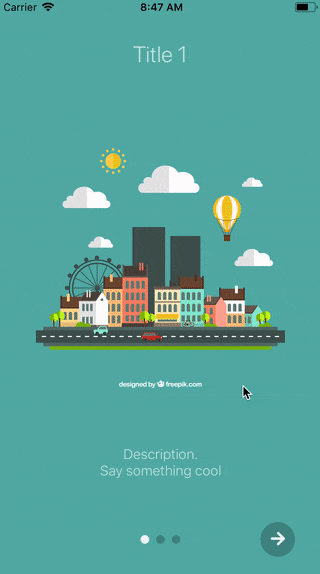 |
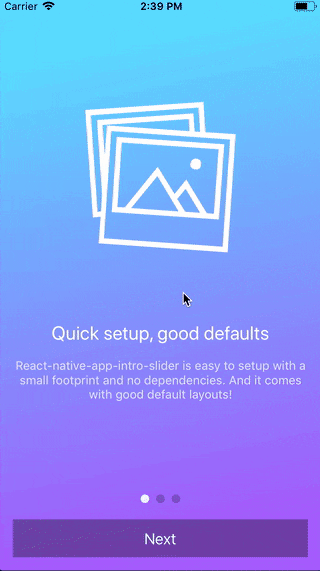 |
| No configuration | showSkipButton |
bottomButton and showSkipButton |
|---|---|---|
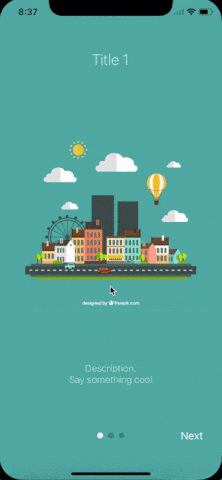 |
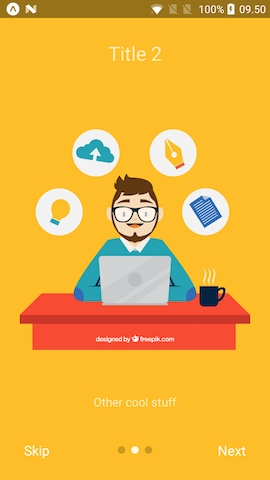 |
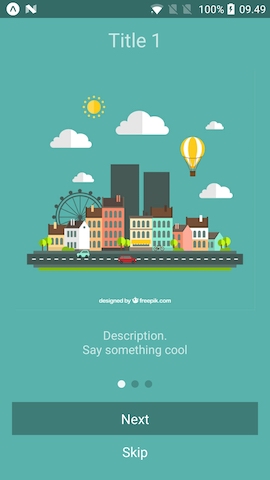 |
The component is based on FlatList so usage is very similar. Pass a data-array to AppIntroSlider along with a renderItem-function (or you can use the default basic layout).
import React from 'react';
import { StyleSheet } from 'react-native';
import AppIntroSlider from 'react-native-app-intro-slider';
const slides = [
{
key: 'somethun',
title: 'Title 1',
text: 'Description.\nSay something cool',
image: require('./assets/1.jpg'),
backgroundColor: '#59b2ab',
},
{
key: 'somethun-dos',
title: 'Title 2',
text: 'Other cool stuff',
image: require('./assets/2.jpg'),
backgroundColor: '#febe29',
},
{
key: 'somethun1',
title: 'Rocket guy',
text: 'I\'m already out of descriptions\n\nLorem ipsum bla bla bla',
image: require('./assets/3.jpg'),
backgroundColor: '#22bcb5',
}
];
export default class App extends React.Component {
this.state = {
showRealApp: false
}
_renderItem = (item) => {
return (
<View style={styles.slide}>
<Text style={styles.title}>{item.title}</Text>
<Image source={item.image} />
<Text style={style.text}>{item.text}</Text>
</View>
);
}
_onDone = () => {
// User finished the introduction. Show real app through
// navigation or simply by controlling state
this.setState({ showRealApp: true });
}
render() {
if (this.state.showRealApp) {
return <App />;
} else {
return <AppIntroSlider renderItem={this._renderItem} slides={slides} onDone={this._onDone}/>;
}
}
}import React from 'react';
import { Ionicons } from '@expo/vector-icons';
import { StyleSheet, View } from 'react-native';
import AppIntroSlider from 'react-native-app-intro-slider';
const styles = StyleSheet.create({
buttonCircle: {
width: 40,
height: 40,
backgroundColor: 'rgba(0, 0, 0, .2)',
borderRadius: 20,
justifyContent: 'center',
alignItems: 'center',
},
image: {
width: 320,
height: 320,
},
});
// slides = [...]
export default class App extends React.Component {
_renderNextButton = () => {
return (
<View style={styles.buttonCircle}>
<Ionicons
name="md-arrow-round-forward"
color="rgba(255, 255, 255, .9)"
size={24}
style={{ backgroundColor: 'transparent' }}
/>
</View>
);
};
_renderDoneButton = () => {
return (
<View style={styles.buttonCircle}>
<Ionicons
name="md-checkmark"
color="rgba(255, 255, 255, .9)"
size={24}
style={{ backgroundColor: 'transparent' }}
/>
</View>
);
};
render() {
return (
<AppIntroSlider
slides={slides}
renderDoneButton={this._renderDoneButton}
renderNextButton={this._renderNextButton}
/>
);
}
}import React from 'react';
import { Ionicons } from '@expo/vector-icons';
import { StyleSheet, View, Text, Image } from 'react-native';
import { LinearGradient } from 'expo';
import AppIntroSlider from 'react-native-app-intro-slider';
const styles = StyleSheet.create({
mainContent: {
flex: 1,
alignItems: 'center',
justifyContent: 'space-around',
},
image: {
width: 320,
height: 320,
},
text: {
color: 'rgba(255, 255, 255, 0.8)',
backgroundColor: 'transparent',
textAlign: 'center',
paddingHorizontal: 16,
},
title: {
fontSize: 22,
color: 'white',
backgroundColor: 'transparent',
textAlign: 'center',
marginBottom: 16,
},
});
const slides = [
{
key: 'somethun',
title: 'Quick setup, good defaults',
text:
'React-native-app-intro-slider is easy to setup with a small footprint and no dependencies. And it comes with good default layouts!',
icon: 'ios-images-outline',
colors: ['#63E2FF', '#B066FE'],
},
{
key: 'somethun1',
title: 'Super customizable',
text:
'The component is also super customizable, so you can adapt it to cover your needs and wants.',
icon: 'ios-options-outline',
colors: ['#A3A1FF', '#3A3897'],
},
{
key: 'somethun2',
title: 'No need to buy me beer',
text: 'Usage is all free',
icon: 'ios-beer-outline',
colors: ['#29ABE2', '#4F00BC'],
},
];
export default class App extends React.Component {
_renderItem = props => (
<LinearGradient
style={[
styles.mainContent,
{
width: props.width,
height: props.height,
},
]}
colors={props.colors}
start={{ x: 0, y: 0.1 }}
end={{ x: 0.1, y: 1 }}
>
<Ionicons
style={{ backgroundColor: 'transparent' }}
name={props.icon}
size={200}
color="white"
/>
<View>
<Text style={styles.title}>{props.title}</Text>
<Text style={styles.text}>{props.text}</Text>
</View>
</LinearGradient>
);
render() {
return <AppIntroSlider slides={slides} renderItem={this._renderItem} bottomButton />;
}
}Here a custom renderItem is supplied and the bottomButton-props has been set to true. Notice how the setup of slides has been configured to support icons and gradient backgrounds.
The component extends FlatList so all FlatList-props are valid.
| Name | Type | Default | Description |
|---|---|---|---|
| skipLabel | string |
Skip |
Custom label for Skip button |
| doneLabel | string |
Done |
Custom label for Done button |
| nextLabel | string |
Next |
Custom label for Next button |
| prevLabel | string |
Back |
Custom label for Prev button |
| bottomButton | boolean |
false |
Enable to show a full-width button under pagination |
| buttonStyle | style |
null |
Styling of outer button component |
| buttonTextStyle | style |
null |
Styling of button text component |
| dotStyle | style |
{backgroundColor: 'rgba(0, 0, 0, .2)'} | Style of inactive pagination dots |
| activeDotStyle | style |
{backgroundColor: 'rgba(255, 255, 255, .9)'} | Style of active pagination dot |
| paginationStyle | style |
null |
Styling of the pagination dots |
| hidePagination | boolean |
false |
Enable to hide the pagination |
| renderNextButton | function |
renders a Text-component | Use to supply your own next button |
| renderPrevButton | function |
renders a Text-component | Use to supply your own prev button |
| renderDoneButton | function |
renders a Text-component | Use to supply your own done button |
| renderSkipButton | function |
renders a Text-component | Use to supply your own skip button |
| renderItem | function |
renders DefaultSlide |
(FlatList's renderItem)[https://facebook.github.io/react-native/docs/flatlist.html#renderitem]. Receives {item, index, dimensions} where dimensions contains height and width of the slides. |
| Name | Type | Default | Description |
|---|---|---|---|
| slides | object |
No default, required | An array of objects (they should either contain a unique key-prop or you should pass a keyExtractor-function to the component) |
| showSkipButton | boolean |
false |
Enable to show a skip button to the left of pagination dots. When bottomButton == true the skip button is a small text under the full-width next button |
| showPrevButton | boolean |
false |
Enable to show a previous button. If showSkipButton is true, the skip button will be displayed on the first page and prev button on subsequent one |
| showNextButton | boolean |
true |
Disable to hide the next button |
| showDoneButton | boolean |
true |
Disable to hide the done button |
| onSlideChange | function |
void |
Called when user goes changes slide (by swiping or pressing next/prev). Function called with arguments index: number, lastIndex: number |
| onDone | function |
void |
Called when user ends the introduction by pressing the done button |
| onSkip | function |
Scroll the list to the end | Called when user presses the skip button |
If you want to use the default slide layout, your slides can contain the following information:
| Name | Type | Note |
|---|---|---|
| title | string |
The title |
| titleStyle | Style-prop |
Styling for the title (e.g color, fontSize) |
| text | string |
Main text of slide |
| textStyle | Style-prop |
Styling for the text (e.g color, fontSize) |
| image | Image-source prop |
Slide image |
| imageStyle | Style-prop |
Styling for the image (e.g. size) |
| backgroundColor | string |
Slide background color |
| Method Name | Arguments | Description |
|---|---|---|
| goToSlide | number |
Change to slide with specified index |
| getListRef | none |
Returns the Flat List ref |
You can run the example Expo-app by cloning the repo:
git clone https://github.com/Jacse/react-native-app-intro-slider.git
cd react-native-app-intro-slider/Example
yarn
yarn start